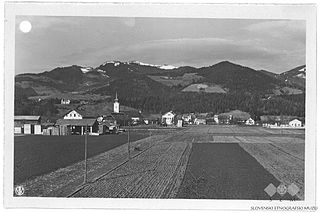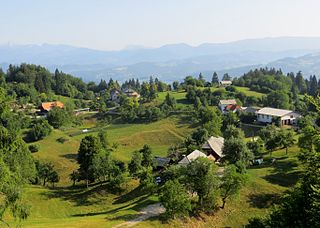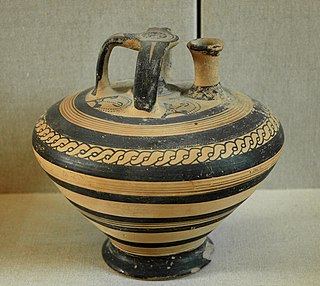
Šmarje pri Jelšah is a town and a municipality in eastern Slovenia. The area was part of the traditional region of Styria. The municipality is now included in the Savinja Statistical Region. The development of the settlement is associated with a medieval mansion known as Jelšingrad on a slight hill northwest of the town.

Šmartno pri Slovenj Gradcu is a settlement in the City Municipality of Slovenj Gradec in northern Slovenia. The area was traditionally part of Styria. The entire municipality is now included in the Carinthia Statistical Region.

Topol pri Medvodah is a small settlement in the Municipality of Medvode in the Upper Carniola region of Slovenia. It lies in the hills northwest of the Slovene capital Ljubljana and is a popular destination for short trips with locals.

Briše pri Polhovem Gradcu is a dispersed settlement just south of Polhov Gradec in the Municipality of Dobrova–Polhov Gradec in the Upper Carniola region of Slovenia. It lies in the valley of Little Creek on the road from Polhov Gradec to Lučine and includes the hamlets of Škofijski Hrib, Zavrh, and Štebavnik. It is surrounded by Praproče Hill and Mount Polhov Gradec to the north, Little Peak to the west, Big Hill to the south, Kladnik Hill to the southeast, and Zvonščica Hill to the east.

Dvor pri Polhovem Gradcu is a village east of Polhov Gradec in the Municipality of Dobrova–Polhov Gradec in the Upper Carniola region of Slovenia.

Dolsko is a settlement northeast of Ljubljana in the Municipality of Dol pri Ljubljani in the Upper Carniola region of Slovenia.

Leskovec pri Krškem is a settlement on the right bank of the Sava River in the Municipality of Krško in eastern Slovenia. The area was traditionally part of Lower Carniola. It is now included with the rest of the municipality in the Lower Sava Statistical Region. It includes the hamlets of Grad, Beli Breg, Veliki Marof, and Žadovinka. Older sources also mention the appertaining hamlet of Bajer.

Dolenje Gradišče pri Šentjerneju is a settlement in the Municipality of Šentjernej in southeastern Slovenia. The area was traditionally part of Lower Carniola. It is now included in the Southeast Slovenia Statistical Region.

Gorenja Gomila is a settlement on the right bank of the Krka River in the Municipality of Šentjernej in southeastern Slovenia. The area was traditionally part of Lower Carniola. It is now included in the Southeast Slovenia Statistical Region.

Gorenje Gradišče pri Šentjerneju is a settlement west of Šentjernej in southeastern Slovenia. The area was traditionally part of Lower Carniola. It is now included in the Southeast Slovenia Statistical Region.

Mihovica is a settlement on the right bank of the Krka River in the Municipality of Šentjernej in southeastern Slovenia. Traditional 19th-century farmhouses and outbuildings are preserved in the village core and it has been included on the Slovenian Ministry of Culture's register of national heritage. The area was traditionally part of Lower Carniola. It is now included in the Southeast Slovenia Statistical Region.

Polhovica is a village in the Municipality of Šentjernej in southeastern Slovenia. Its territory extends to the woods west of the main settlement up to the banks of the Krka River. The entire municipality was traditionally part of Lower Carniola. It is now included in the Southeast Slovenia Statistical Region.

Šmarje is a settlement in the Municipality of Šentjernej in southeastern Slovenia. It was traditionally part of Lower Carniola and is now included in the Southeast Slovenia Statistical Region.

Tolsti Vrh is a settlement in the foothills of the Žumberak/Gorjanci range in the Municipality of Šentjernej in southeastern Slovenia. It was traditionally part of Lower Carniola and is now included in the Southeast Slovenia Statistical Region.

Katarija is a settlement in the hills south of Moravče in central Slovenia. Traditionally the area was part of Upper Carniola. It is now included with the rest of the Municipality of Moravče in the Central Slovenia Statistical Region. In addition to the main settlement, it includes the hamlets of Vrh Svetega Miklavža and Grmače.

Lemberg pri Šmarju is a settlement in the Municipality of Šmarje pri Jelšah in eastern Slovenia. It lies in the hills northeast of Šmarje. The area was traditionally part of Styria. The municipality is now included in the Savinja Statistical Region.

Šentvid pri Grobelnem is a village in the Municipality of Šmarje pri Jelšah in eastern Slovenia. It lies on the regional road from Šmarje to Celje. The area was traditionally part of Styria. The municipality is now included in the Savinja Statistical Region.

Buče is a settlement in the Municipality of Kozje in eastern Slovenia. It lies in the Sava Hills northwest of Kozje. The area is part of the historical Styria region. The municipality is now included in the Savinja Statistical Region.

Planina pri Sevnici is a village in the Municipality of Šentjur in eastern Slovenia. The area is part of the historical region of Styria. The municipality is now included in the Savinja Statistical Region.

Pugled pri Starem Logu is an abandoned settlement in the hills north of the town of Kočevje in southern Slovenia. The area is part of the traditional region of Lower Carniola and is now included in the Southeast Slovenia Statistical Region.




















